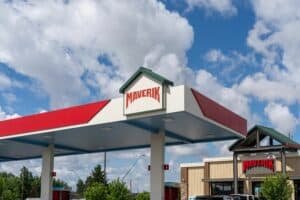
Image Courtesy of ALDI
February 11, 2025
ALDI Makes a Deeper Push Into National Grocery Market, Opening 225 Stores in 2025 as Part of 5-Year Strategy
ALDI may be a favorite of many consumers — primarily known for stocking groceries, but also somewhat famous for its ironically popular “aisle of shame,” or ALDI Finds aisle, which stocks home goods and lifestyle products — and if you’re one of these, you’re likely happy about this bit of latest news.
ALDI has announced plans to embark on its most significant U.S. expansion yet, according to Retail TouchPoints, in a somewhat complex business move.
ALDI To Open Over 225 Locations in 2025 Alone, Picking and Choosing Its Markets
As part of its massive five-year national growth strategy, ALDI has announced the planned opening of over 225 new locations by the end of 2025, the most stores opened in one year in the company’s almost 50-year history. Fueled in part by the conversion of selected Winn-Dixie and Harveys Supermarket locations that it acquired as part of its 2023 purchase of Southeastern Grocers, ALDI seeks to rebrand these stores under its own banner as part of its path forward.
The grocer isn’t converting all of its purchased locations, however. Earlier this week, it sold off 170 locations it purchased via the aforementioned acquisition to a consortium of investors headed up by the current CEO and president of Southeastern Grocers. Those it opted to retain, however, will be folded into the ALDI brand and re-opened under its banner.
“When we announced our acquisition of Southeastern Grocers, we shared that we intended for a meaningful number of Winn-Dixie and Harveys Supermarkets to continue to operate, and we’re delivering on that promise while also supporting ALDI growth,” CEO Jason Hart stated in a press release.
While approximately 100 locations are set to re-open as ALDI stores by the end of 2025, a total of 220 stores are slated for rebranding by the end of 2027.
“Converting the remaining locations to the ALDI format is critically important to our nationwide commitment to help shoppers fill their carts with quality groceries for less. As shoppers continue to feel sticker shock at the checkout, the value ALDI delivers can’t be beat,” added Hart.
ALDI Expansion Also Fueled by Organic Growth, New Builds
Not all of ALDI’s new stores this year will be conversions of old grocery locations, however. As 8NewsNow detailed, for example, the chain is set to open three new Las Vegas Valley locations in the near future.
“We are excited to share that our stores in Las Vegas and North Las Vegas are expected to open later this spring. We have lots of fun plans coming to the market so as we get closer to the opening, we’ll be sure to reach back out with more details on the new stores,” said Shawn Eddy, Moreno Valley divisional vice president at ALDI.
In 2024, the grocery chain opened 120 new stores — becoming the nation’s third-largest grocer in the process. The brand has built a reputation centered around its value proposition, which, in tandem with an extensive array of private-label products, has driven continued consumer interest during a time of persistent inflation and tightened purse strings.
“ALDI continues to see more shoppers come through our doors as they experience our quicker, easier and more affordable shopping experience firsthand,” Hart continued. “With our expansion across the country, ALDI is earning the trust of more shoppers in more communities than ever before, bringing us closer to becoming America’s first stop for groceries.”
ALDI Lauded for Selective Yet Impressive Growth Opportunities
At least one analyst was impressed with the grocer’s latest move. Grocery Dive lead editor Jeff Wells dissected the recent news of ALDI’s expansion, lauding the grocery chain for its business finesse in coupling news of the massive selloff of assets it had just acquired with the announcement of targeted expansion plans to secure its position as a serious contender against Walmart, Costco, Kroger, and others.
Wells further cemented his belief that ALDI’s strong emphasis on value and customer experience has distinguished it from other discount grocers. All factors combined, Wells was bullish on ALDI’s future prospects.
“Parlor tricks aside, ALDI is growing at a breakneck pace in the U.S. The message to consumers and to the grocery industry is this: It’s our time now,” Wells wrote.
“ALDI really seems to be firing on all cylinders right now but something that I keep coming back to with the discounter is a question: Do consumers love shopping at ALDI? The shopping experience is way better than before its remodeling campaign, back when ALDI’s stores were generally seen as dreary, bare-bones places to shop. Nowadays, ALDI shoppers get great prices and a more attractive shopping environment along with trending products and unique finds,” Wells continued.
The Grocery Dive editor then pivoted to offer an even-handed critique of ALDI’s current business practices, saying its stores still lack the warmth and personality of competitors such as Trader Joe’s, Publix, and H-E-B. Culprits include the outmoded quarter-in-a-shopping-cart requirement as well as the somewhat omnipresent understaffing common to almost all retail segments in the modern era.
Wells leaves the reader hanging on a bit of a cliffhanging, posing the question of whether a hard focus on low prices at the expense of customer amenities is here to stay, or rather a simple sign of the (economically distressed) times. That question, valid though it may be, has yet to be put to the test.
Discussion Questions
Is ALDI’s rapid expansion, while selling off less desirable stores it has acquired, wise? Why or why not?
What brand differentiators have allowed ALDI to surge in popularity with American consumers? Does its rapid expansion put these differentiators at risk, or can it successfully retain these markers throughout its growth plan?
What can (or will) competitors do to outcompete ALDI as it pushes into their market?
Poll
BrainTrust
Shep Hyken
Chief Amazement Officer, Shepard Presentations, LLC
Mark Self
President and CEO, Vector Textiles
Brian Numainville
Principal, The Feedback Group
Recent Discussions







As a low-price operator, Aldi is on the right side of consumer trends. However, it is also highly rated on the taste and quality of its food and the ambiance of its stores. This means it has a very strong value proposition and is the reason it has been securing more customers. Given Aldi’s extremely efficient operating model (maximizing volume through a relatively limited number of SKUs, lots of own label, etc.), it is hard for many mainstream supermarkets to match it on price. And Aldi will continue to eat away at their market share as it opens more stores. Frankly, that’s the kind of competitive dynamic some of the lackluster traditional supermarkets need to put a rocket under them!
Aldi’s growth continues unabated. In addition to aggressive U.S. expansion, the company is investing in e-commerce capabilities and exploring new product categories.
Aldi’s commitment to innovation and customer satisfaction is evident in its strategic focus on expanding its online presence and diversifying its product offerings. This approach not only strengthens its market position but also caters to the evolving needs of its customer base.
Additionally, Aldi is enhancing its online presence and digital capabilities. They have launched a new website and mobile app to improve the user experience and streamline online shopping.
Aldi is well positioned to capture an even larger share of the U.S. grocery market as it expands its footprint and innovates its offerings. Aldi is predicted to reach $60 billion in annual sales by 2030. This growth trajectory underscores Aldi’s adaptability and foresight in a competitive market, ensuring sustained relevance and customer loyalty.
Aldi, has several differentiators that are well aligned with the strategy of being selective on locations and not over saturating markets that do not contain their target market. In addition to being a lower price operator they generally have a smaller foot print with bright lighting simplifying and expediting the shopping experience. They have a good balance of quality products with effective operations driven by a small store and a limited SKU count. This combination leads to a customer demographic that they understand and are in a position to exploit without needing to carry the burden of underperforming locations.
In our research, we’ve seen Aldi as a formidable competitor in that they win on low prices while offering average quality for produce but weak quality for meat. But if a shopper can live within the more limited variety available, Aldi offers a very good value for money spent. They will continue to eat into market share as they grow in new and existing markets.
ALDI’s is in a sweet spot in the grocery market, especially with rising prices and shrinking wallets. Consumers are trying to stretch their grocery budget and Aldi is benefiting from price conscious consumers. While the offerings are very limited at ALDI, some consumers will shop ALDI for some basic items and supplement their shopping list from traditional grocery stores. The most serious threat to ALDI is Lidl, but Lidl’s market areas are condensed to the eastern part of the U.S.
Aldi is in the enviable position of having the right business model, in the right place, at the right time. Good for them!
If a retailer has a chance to eliminate less desirable stores, why wouldn’t they? ALDI is doing what any good retailer would do: finding successful locations and eliminating those (when able to) that are not.
While many brands sell value, some deliver better than others. As CEO Hart said, “…fill their carts with quality groceries for less.” That’s a good mantra that when consistently delivered, which ALDI does, will build trust and confidence with their customers. They know what to expect.
What will competitors do as ALDI enters their market? The same thing retailers did when Walmart came into their neighborhood. Or what happens when Home Depot and Lowes (or other big box home improvement centers) move next door to an Ace Hardware store with a much smaller footprint and an advertising budget that is a fraction of the big box retailers? They do what smart retailers do. They find their strengths, make sure the public knows them, and build from there – and that’s just one of many strategies to consider.
Aldi made the right moves in keeping stores in the most attractive areas while selling off stores that would not work in the long-run. Besides having superior prices, Aldi differentiates with a well-organized and easy to navigate stores for shoppers. The retailer also continues to bring in meaningful assortments over the years that are important to consumers such as an expanded organic line as well as a larger assortment of higher protein products. Aldi is well positioned in this price conscious era and into the future.
Aldi has outgrown its “silent killer” monicker. Upon arrival in the US most markets didn’t know of Aldi’s plans until the stores actually opened. No longer is Aldi’s strategy a secret. It is a terrific value operator who knows its strengths & weaknesses.
Hard to believe it comes from the same family as Trader Joe’s. Aldi is content to have a no frills approach to market success. Traditional supermarkets should be concerned. Probably the biggest impediment to its continued growth is not any traditional food retailer, but another German value operator – Lidl.